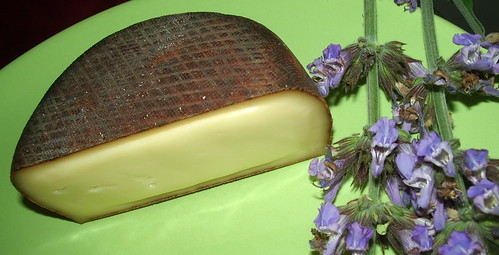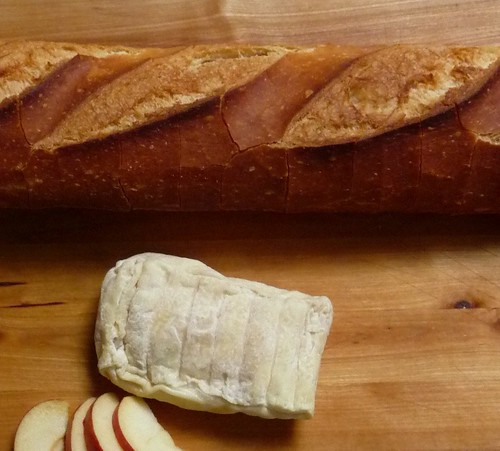This year at the Winter
Fancy Food Show I was chosen to be one of the "trendspotters" for the
National Association for the Specialty Food Trade. As part of a small group of editors, writers and chefs, I helped to identify a
number of trends. But that was just the beginning. I saw and tasted a lot of other interesting and appealing things. There were cultured, pastured and hand rolled butters, snacks made from seaweed, shortbread cookies flavored with herbs and flowers and lots of lovely chutneys, jams, vinegars and olive oils. Here are some new things I had not seen or tried before that each made a positive impression on me. I hope you get to try them soon!

These wacky little fruit,
Shanley Farms Finger limes, look like cornichons. Inside they have little beads of a very mild lime juice. It's like some kind of molecular gastronomy experiment only from nature! Crunchy caviar-like beads of lime would be great on oysters, smoked salmon, guacamole; I can think of almost many ways to use them. The season is October through mid January and they keep up to three weeks, so you keep your eyes out for them.

Saba is a thick syrup made from grapes. It comes from Italy and is not easy to find. This is the first time I have seen a producer from within the US.
Saba from Terra Sonoma is lovely. It's thick and rich and would is terrific as a sauce or marinade. It can also be drizzled over things like ricotta, ice cream, yogurt or even hummus.

I am obsessed with wine pairing. Because I fully appreciated wine even more when served with food, I'm always interested to learn about cookies, crackers, cheeses or other snacks that are specifically designed to go with wine.
Cookies & Corks, wine pairing cookies come in a variety of flavors and there are charts to help you figure out what pairs with what. There are about 15 cookies in three flavors in each box to go with red, white or sparkling wine. If you are hosting a wine tasting party or looking for the perfect gift to go with a bottle of wine, this is it!
 Vin Tucci wine cookies
Vin Tucci wine cookies not only taste good with wine, they are made from wine! I really like the crunchy light texture. There are several flavors, anise, spice and honey but none of them are very sweet. They are sophisticated and because they contain no butter, oil or eggs, they are fairly healthy. Look for them in speciality food stores. I think they're just great.

So you might be thinking what's new about charcuterie and salumi? Been there, done that. Well
Olli Salumeria is really special. Oliviero Colmignoli is a fourth generation Italian salumi maker who makes his products here in the US using heritage breeds of pork. He is making prosciutto, speck and even culatello! Other companies I love that are also making fabulous artisanal salumi are
La Quercia and
Creminelli but Olli is brand new.
 Zocalo Gourmet, Heritage flours
Zocalo Gourmet, Heritage flours offers a line of products I didn't get a chance to try, but am very curious about. They are gluten-free flours made from a wide variety of ingredients. I'm sure they add different flavors and textures to whatever you use them in. The gluten-free folks have gotten a head start experimenting with all kinds of flours. I look forward to working with them soon too. Varieties include mesquite, purple corn, sweet potato, and lima bean.

Sometimes it feels like the Fancy Food Show is nothing but tea, chocolate and cheese. It all blurs together. However new
Poco Dolce Olive Oil with Sea Salt chocolate bars really stood out from the rest. They have a seductively soft creamy texture that is indescribably good. You just have to try them.

Last year I wrote about those crazy folks from Lillie Belle Farms, who made a blue cheese truffle. It sounds dreadful but one bite and you are converted. Now, instead of eating a bon bon, you can slather the
Smoky Blue Cheese Truffle Spread, basically a smoky blue cheese chocolate ganache on bread. Oh man, this is nothing but trouble!
 SanTasti water
SanTasti water is a palate cleansing sparkling water. And it really works! At the Show there was no shortage of flavors to try and neutralize. The water has a touch of sugar to balance the acidity, but it doesn't taste sweet. It has some fruit pectin and cellulose gum which bind to the tannins left in your mouth from something you've eaten or drank like wine or chocolate. It also has a bit of citric acid which helps refresh your mouth. You don't taste the additives and it just tastes like fresh water but it does remove the flavors of whatever you've just eaten or drank. It's perfect for wine tasting. You can get a free
sample if you like (you will have to pay for shipping and handling).

This is a tease. My friend Andy works for a cheese importer and happened to have a bag of these insanely sweet and crisp chiles from Basilicata. One crunchy bite and you will swear off potato chips forever. I am not kidding! I It looks like you can get these at
Zingerman's and even cheaper from
Market Hall Foods. Here's
recipe from Rosetta Constantino for making them at home.
Note: Andy tells me "Others may have the peperoni cruschi but they're not the same ones. I should have them here soon and hopefully for a lot less."









 La Journée National Slow Food in les Halles in Narbonne.
La Journée National Slow Food in les Halles in Narbonne.





 My deck plants rest this winter after the cold spell in December (see prvious post!) and at the market I bought a tray of hyacinths, pink and white, to bring a note of color to my Parisian winter.
My deck plants rest this winter after the cold spell in December (see prvious post!) and at the market I bought a tray of hyacinths, pink and white, to bring a note of color to my Parisian winter. In France, the "galette" is a speciality pastry that celebrates Epiphany, a christian celebration to remember the visit of Kings to Jesus on January 6th.
In France, the "galette" is a speciality pastry that celebrates Epiphany, a christian celebration to remember the visit of Kings to Jesus on January 6th. This year, I bought the traditional bordelaise galette, a brioche crown with dry fruit and candied sugar on top, at Maison Delcourt, a very good bakery near my home.
This year, I bought the traditional bordelaise galette, a brioche crown with dry fruit and candied sugar on top, at Maison Delcourt, a very good bakery near my home. Maison Delcourt is rue Boileau and has delicious bread, pastries, chocolates, and marrons galces, and I stop by when I do my market at the Porte de Saint Cloud on Sundays.
Maison Delcourt is rue Boileau and has delicious bread, pastries, chocolates, and marrons galces, and I stop by when I do my market at the Porte de Saint Cloud on Sundays. Here is yet another fine menu for the Holiday season.
Here is yet another fine menu for the Holiday season.  > Cheese Souffle
> Cheese Souffle 

 Last week Emily and Amos came for dinner. They had toured Burgandy before coming to Paris and were delighted with their trip! Chablis, Vezeley, Dijon ... so much to see ... and taste!
Last week Emily and Amos came for dinner. They had toured Burgandy before coming to Paris and were delighted with their trip! Chablis, Vezeley, Dijon ... so much to see ... and taste!  Then came the Mediterrannean clafoutis, a savory clafouty made with fresh tomatoes and sun dried tomatoes.
Then came the Mediterrannean clafoutis, a savory clafouty made with fresh tomatoes and sun dried tomatoes.
 Then I served a large bowl of salad, seasoned with olive oil and red wine vinegar, and a traditional cheese platter with one sheep cheese (from Pyrennees), a blue cheese (I opted for Roquefort, made also with shee milk), a classic Emmental, and a goat cheese (Crotin).
Then I served a large bowl of salad, seasoned with olive oil and red wine vinegar, and a traditional cheese platter with one sheep cheese (from Pyrennees), a blue cheese (I opted for Roquefort, made also with shee milk), a classic Emmental, and a goat cheese (Crotin).





 This meal was a bit on the beige side, but then again last Sunday was a beige day. Saturday was gloriously sunny, and Sunday started to veer to grey...and somehow, that made for beige weather.
This meal was a bit on the beige side, but then again last Sunday was a beige day. Saturday was gloriously sunny, and Sunday started to veer to grey...and somehow, that made for beige weather.


















